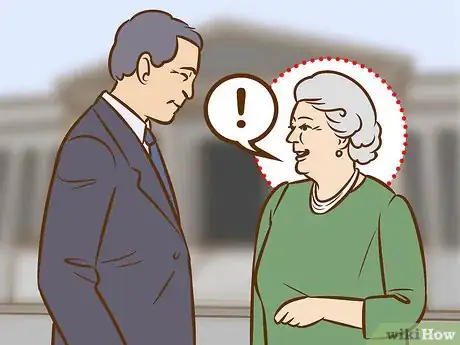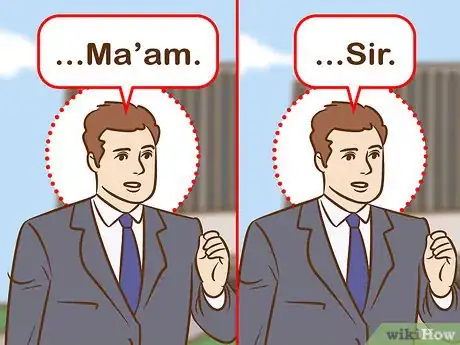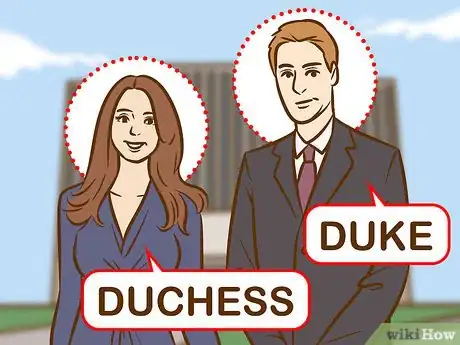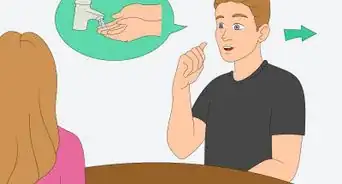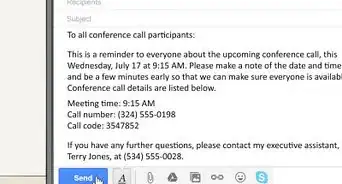This article was co-authored by wikiHow Staff. Our trained team of editors and researchers validate articles for accuracy and comprehensiveness. wikiHow's Content Management Team carefully monitors the work from our editorial staff to ensure that each article is backed by trusted research and meets our high quality standards.
There are 10 references cited in this article, which can be found at the bottom of the page.
wikiHow marks an article as reader-approved once it receives enough positive feedback. In this case, 91% of readers who voted found the article helpful, earning it our reader-approved status.
This article has been viewed 622,229 times.
Learn more...
A long history of etiquette establishes how to show respect to a member of the British aristocracy. In the modern day, no one requires these courtesies, and you're unlikely to annoy the noble as long as you are polite. However, if you would like to avoid embarrassment at a formal event, it only takes a moment to discover the preferred mode of address of the other guests.
Steps
Formal Address Cheat Sheet
Addressing the British Royal Family
-
1Greet royalty with a small bow or curtsy. These are the most formal greetings, but they are never required, even for subjects of the King. If you are a man and you choose this approach, bow your head slightly at the neck.[1] If you are a woman, give a small curtsy: put your right foot behind your left, then briefly bend at the knees while keeping your upper body and neck vertical.[2]
-
2Consider a small nod or bob instead. Instead of bowing or curtsying, you may give a small nod (traditionally male) or bob by briefly bending your knees (female). This is a typical choice for people who are not citizens of the Commonwealth, since they have no fealty to British royalty.[5] This is also perfectly acceptable for Commonwealth citizens.[6]Advertisement
-
3Shake hands only if the offer is extended. The Royal Family's website states that shaking hands is also an acceptable form of greeting, alone or in addition to one of the modes above.[7] However, you should wait for the Royal Family Member to extend his or her hand first, and use only a light touch with one hand.[8] Do not initiate any physical contact yourself.
- If you are wearing dress gloves (which is certainly not required), men should remove the gloves before shaking hands, while women may leave them on.[9]
-
4Let the royal personage take the lead in conversation. Wait until he or she greets you before you speak. Avoid changing the subject, and do not ask any personal questions.[10]
- Foreigners should resist the urge to speak "proper" if it comes across as an imitation of an English accent. The King and his relatives have spoken with thousands of people around the world, and do not expect you to speak as they do.
-
5Use the full formal address in your first reply. If addressed by royalty, your first response should end with the long form of respectful address. For example, if the King asks you "How are you enjoying the United Kingdom?" you could respond, "It's wonderful, Your Majesty." For all other members of the royal family besides the King, your first response should use "Your Royal Highness" instead.[11]
-
6Use short forms of address for the rest of the conversation. All female members of the Royal Family, should be addressed as "Ma'am", with a short "a" as in "jam". Address all male members as "Sir".[12]
- If you mention a royal family member in the third person, always use a full title (such as "The Prince of Wales") or "His/Her Royal Highness". Referring to someone by name ("Prince Philip" ) may be considered rude.[13]
- Note that the correct title for the King is "His Majesty the King". Avoid "King of England", as that is just one of many titles that refer to a specific country.
-
7Repeat the same greeting when the Royal Family member leaves. Use the same bow, curtsy, or less traditional greeting as a respectful farewell when the meeting comes to an end.[14]
-
8Contact the Royal Household if you have further questions. The staff of the Royal Household is happy to answer etiquette questions. If you are not sure of the preferred title for a particular royal, or the expectations for hosting a particular event, enquire by post or telephone:[15]
- (+44) (0)20 7930 4832
- Public Information Officer
Buckingham Palace
London SW1A 1AA
Addressing British Nobility
-
1Address dukes and duchesses by title. These belong to the highest grade of peerage. Address them as "Duke" or "Duchess". After the initial greeting, you may address them the same way or as "Your Grace".
- As with any title, you do not need to include the location ("Duke of Mayfair") unless it is necessary to avoid confusion.
- If you are making a formal introduction, say "His/Her Grace the Duke/Duchess" followed by the rest of the title.
-
2Refer to all lower ranks by Lady and Lord. In conversation and verbal introductions, avoid reference to all other titles besides Duke or Duchess. Use "Lady" and "Lord" instead, followed by the last name.[16] The following titles are only used in formal or legal correspondence:
- Marchioness and Marquis
- Countess and Earl
- Viscountess and Viscount
- Baroness and Baron
-
3Address the peer's children by courtesy titles. This can get slightly complicated, so look up the exact scenario below:
- Address the son of a duke or marquess as "Lord" followed by the first name.
- Address to the daughter of a duke, marquess, or earl as "Lady" followed by the first name.
- If you will be meeting a peer's heir apparent (generally the eldest son), look up his title. He will often use a secondary title of his father's, which is always of a lower rank.
- In all other cases, the child has no special title. ("The Hon." is used only in writing.)
-
4Speak with baronets and knights. Use the following guide when talking to someone who holds these non-noble distinctions:
- Baronet or Knight: "Sir" followed by the first name
- Baronetess and Dame: "Dame" followed by the first name
- Wife of a baronet or knight: "Lady" followed by the first name
- Husband of a baronetess or dame: no special title[17]
Community Q&A
-
QuestionHow do I address a royal prince?
 Community AnswerAt first meeting he is address with Your Royal Highness, and Sir thereafter.
Community AnswerAt first meeting he is address with Your Royal Highness, and Sir thereafter. -
QuestionWhat happens if you accidentally say something or act impolite?
 Community AnswerIn all honesty, just apologize.
Community AnswerIn all honesty, just apologize. -
QuestionWhen do you use the title "Your ladyship"?
 Community AnswerWhen you address a lady or countess (wife of an earl). If you would normally say 'you' in the context, then substitute it for 'your ladyship'. For example: "Have you finished lunch yet?" would become "Has your ladyship finished lunch yet?".
Community AnswerWhen you address a lady or countess (wife of an earl). If you would normally say 'you' in the context, then substitute it for 'your ladyship'. For example: "Have you finished lunch yet?" would become "Has your ladyship finished lunch yet?".
Warnings
- If you are caught unprepared, it's probably better to admit ignorance rather than "winging it." If possible, ask a protocol officer or another un-ranked or lower-ranked person.⧼thumbs_response⧽
- This article deals specifically with meeting British peers and royalty. Aristocracies in other countries may have different etiquette, and (unlike the British) may punish you for failing to observe the correct codes of behavior.⧼thumbs_response⧽
References
- ↑ https://www.royal.uk/greeting-member-royal-family
- ↑ https://www.insider.com/14-etiquette-rules-the-royal-family-must-always-follow-2017-8
- ↑ http://www.theroyalarticles.com/articles/65/1/Protocol-and-Etiquette-a-Very-Royal-Perspective/Page1.html
- ↑ http://www.theroyalarticles.com/articles/65/1/Protocol-and-Etiquette-a-Very-Royal-Perspective/Page1.html
- ↑ https://www.washingtonpost.com/news/reliable-source/wp/2014/12/04/how-to-greet-prince-william-and-other-royal-etiquette/
- ↑ https://www.royal.uk/greeting-member-royal-family
- ↑ https://www.royal.uk/greeting-member-royal-family
- ↑ http://www.telegraph.co.uk/news/uknews/the_queens_diamond_jubilee/9267342/Royal-glove-maker-Those-gloves-will-take-a-beating.html
- ↑ https://www.washingtonpost.com/lifestyle/style/miss-manners-men-let-the-gloves-come-off-before-you-shake-hands/2014/09/02/138b890e-2faa-11e4-994d-202962a9150c_story.html
- ↑ http://www.theroyalarticles.com/articles/65/1/Protocol-and-Etiquette-a-Very-Royal-Perspective/Page1.html
- ↑ https://www.royal.uk/greeting-member-royal-family
- ↑ https://www.royal.uk/greeting-member-royal-family
- ↑ http://www.theroyalarticles.com/articles/65/1/Protocol-and-Etiquette-a-Very-Royal-Perspective/Page1.html
- ↑ https://www.insider.com/14-etiquette-rules-the-royal-family-must-always-follow-2017-8
- ↑ https://www.royal.uk/contact?page=13&ch=3
- ↑ http://www.hmsrichmond.org/avast/titles12.html
- ↑ http://lordsoftheblog.net/2013/10/25/equality-for-husbands/
- ↑ http://www.theroyalarticles.com/articles/65/1/Protocol-and-Etiquette-a-Very-Royal-Perspective/Page1.html
- ↑ http://www.formsofaddress.info/BRI.html
About This Article
To formally address British royalty and aristocracy in person, give a small nod if you’re a male, or a brief bob by bending slightly at the knees if you’re a female. Then, let them initiate the conversation and use the full formal address in your initial reply, such as “Yes, your majesty,” for a royal member. With members of the aristocracy, address Dukes and Duchesses as “Your Grace,” and all lower ranking members like Barons and Earls as “”Lord” and “Lady.” After the initial response, you can use “Ma’am” or “Sir” for the rest of the conversation. To learn more, including how to address members with non-noble titles, like baronets and knights, read on!




